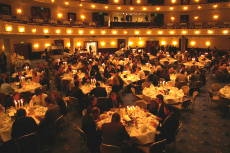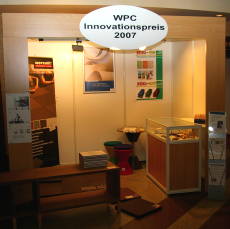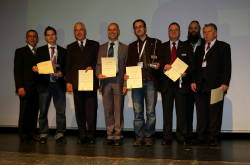On 4th and 5th December 2007, the nova-Institut organised the “Second German WPC Congress” in the Maritim Hotel Cologne. With more than 350 participants from 25 countries and 30 exhibitors, it was the largest European WPC congress in recent years and the most important meeting point of the industry. WPC stands for “Wood Plastic Composites”, the German translation is “Holz-Polymer-Werkstoffe”. They are composites that are typically made from wood flour and plastics such as polypropylene or polyethylene.
 Compared to the “First German WPC Congress” in the year of 2005, a couple of positive trends became evident. For example, within two years only, the German WPC production volume has risen from 5,000 tons in 2005 to about 20,000 tons in 2007. nova-Institut estimates the present production volumes in Europe at about 100,000 tons. Germany/Austria, Benelux and Scandinavia are the leading regions. These figures refer to the building and furniture industry. In the European automotive industry, another 50,000 tons WPC are used per annum.
Compared to the “First German WPC Congress” in the year of 2005, a couple of positive trends became evident. For example, within two years only, the German WPC production volume has risen from 5,000 tons in 2005 to about 20,000 tons in 2007. nova-Institut estimates the present production volumes in Europe at about 100,000 tons. Germany/Austria, Benelux and Scandinavia are the leading regions. These figures refer to the building and furniture industry. In the European automotive industry, another 50,000 tons WPC are used per annum.
Terrace floorings are the most important sales market for WPC that have a market share of about 6% in this sector. Shares of 20% are considered possible for the next years, mainly as a substitute for tropical timbers. The number of applications in the furniture industry, amongst others incl. several chairs and shelving systems, has increased significantly.
Apart from these advancements in terms of quantities, there also were important developments regarding quality. While two years ago customer expectations and properties of WPC products respectively were the focus of questions, particularly with concern to durability in outdoor applications, this was not discussed any longer on this year`s congress. The current products are of high quality, being able to meet the customer expectations for the important properties mechanical strength, durability and colour fastness. The VHI seal of approval presented for the first time at the congress (see news of 2008-01-18) indicates this development.
 The political-strategic discussion at the congress focused on the term “biomaterial” that covers the entire sector of new materials made from renewable resources. Besides WPC, also bioplastics and natural fibre-reinforced plastics fall in this category. nova-Institut estimates that these new materials do have a market volume of at least 350,000 t per year in Europe meanwhile. As for CO2 emissions, the materials have significant advantages over common materials. That’s why they should gain a similar degree of political support as biofuels and bioenergy in general. So far, however, the opposite is true: The subsidies in the bioenergy sector are steering the flow of raw materials from material utilisation to energy recovery. The result: The material utilisation sector increasingly has difficulties in getting sufficient raw material supplies in competition with energy recovery. Cascade utilisation could be a solution – here the renewable resources at first are put to material utilisation one or several times and used for energetic recovery only in the end. Because, like Dr. Sauerwein from VHI said: “You can burn it only once”.
The political-strategic discussion at the congress focused on the term “biomaterial” that covers the entire sector of new materials made from renewable resources. Besides WPC, also bioplastics and natural fibre-reinforced plastics fall in this category. nova-Institut estimates that these new materials do have a market volume of at least 350,000 t per year in Europe meanwhile. As for CO2 emissions, the materials have significant advantages over common materials. That’s why they should gain a similar degree of political support as biofuels and bioenergy in general. So far, however, the opposite is true: The subsidies in the bioenergy sector are steering the flow of raw materials from material utilisation to energy recovery. The result: The material utilisation sector increasingly has difficulties in getting sufficient raw material supplies in competition with energy recovery. Cascade utilisation could be a solution – here the renewable resources at first are put to material utilisation one or several times and used for energetic recovery only in the end. Because, like Dr. Sauerwein from VHI said: “You can burn it only once”.
Apart from the numerous interesting lectures on technical questions such as surface treatment, UV protection and process optimisation, the two WPC innovation awards, offered by nova-Institut (Hürth) and the Reifenhäuser company (Troisdorf), were the highlights of the congress. From a total of 15 entries filed in time, an expert jury consisting of partners and sponsors nominated a preselection of three promising innovations each in the categories “product” and “process”. Now the congress visitors were expected to choose the winners, based on short lectures and the exhibits presented.
A shelving system made from extruded WPC combshaped construction profiles with patented injection-moulded binders was chosen as the undisputed winner. With this system it is possible to tailor the particularly lightweight shelf to any lengths, ship it and let it be individually mounted by the customer. The product was developed by the young entrepreneurs of mehrwerk designlabor from Halle/Saale. Runner-ups were the coffered decking “terraZa” from Werzalit and the new, flexible WPC products from Wacker Polymer Systems based on PVAC.
 In the “process” category, it was a somewhat closer public decision. The linear vibration welding technique from the Swiss Fentech AG company for the production of FibrexTM compounds for window construction took first place, with the recipe and process engineering of Reinü-Fefa Produktions GmbH (Zeulenroda, GER) for the production of WPC made from MDF dusts from furniture construction as a close runner-up. The advancement of rotomoulding for coloured WPC, also on a hardwood base, from PHK-Polymertechnik GmbH of Wismar, took third place.
In the “process” category, it was a somewhat closer public decision. The linear vibration welding technique from the Swiss Fentech AG company for the production of FibrexTM compounds for window construction took first place, with the recipe and process engineering of Reinü-Fefa Produktions GmbH (Zeulenroda, GER) for the production of WPC made from MDF dusts from furniture construction as a close runner-up. The advancement of rotomoulding for coloured WPC, also on a hardwood base, from PHK-Polymertechnik GmbH of Wismar, took third place.
All entries, and also the 21 congress lectures, information on speakers and exhibitors as well as partners and sponsors, are published in the 410 pages proceedings. These can be ordered via the website www.wpc-kongress.de. The print version of the proceedings costs 30,- € (ISBN: 978-3-9812027-0-0), the CD-ROM with all congress lectures and the award winners in detail 195,-€. Further nformation on the congress and exhibitors as well as a participant list are also available on the website.
Contact
Christian Gahle
nova-Institut GmbH
Chemiepark Knapsack
50351 Huerth
GERMANY
Tel.: 02233-48 14 40
Fax.: 02233-48 14 50
E-Mail: christian.gahle@nova-institut.de
Internet: www.nova-institut.de/nr
(Cf. news of 2005-11-17, 2007-10-15, 2007-04-20 and 2007-01-21.)
Download this press release as PDF file: 08-01-21_WPC_PM_nova-Institut_EN_kl
Source
nova-Institut GmbH, press release, 2007-12-06.
Share
Renewable Carbon News – Daily Newsletter
Subscribe to our daily email newsletter – the world's leading newsletter on renewable materials and chemicals









